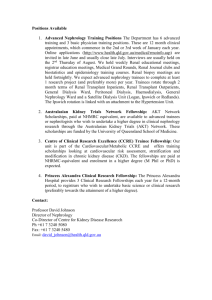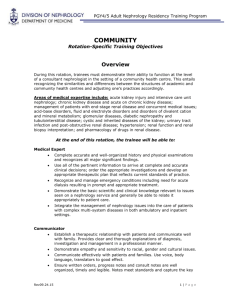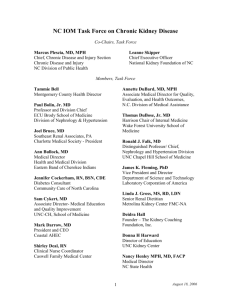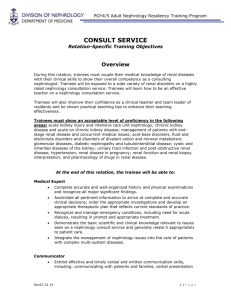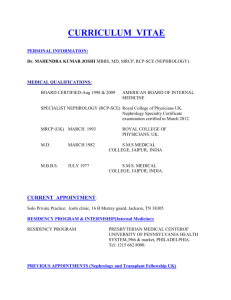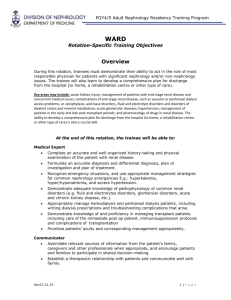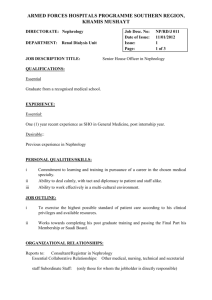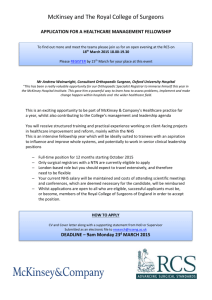Project-Reportback-Template_CSH_revised2
advertisement
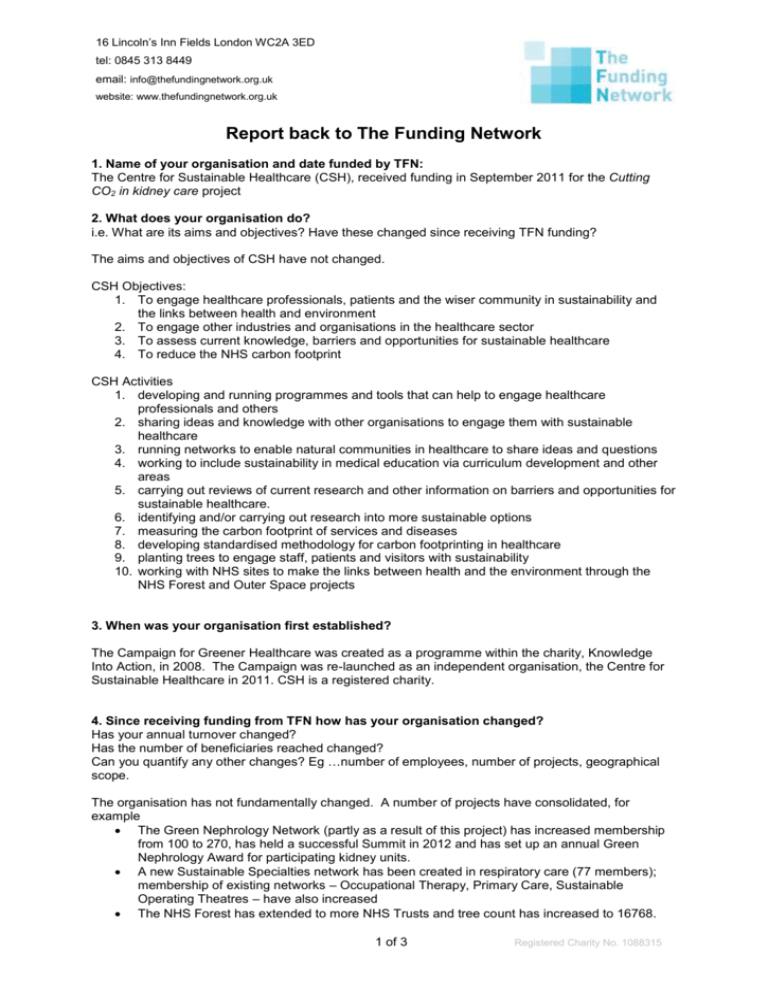
16 Lincoln’s Inn Fields London WC2A 3ED tel: 0845 313 8449 email: info@thefundingnetwork.org.uk website: www.thefundingnetwork.org.uk Report back to The Funding Network 1. Name of your organisation and date funded by TFN: The Centre for Sustainable Healthcare (CSH), received funding in September 2011 for the Cutting CO2 in kidney care project 2. What does your organisation do? i.e. What are its aims and objectives? Have these changed since receiving TFN funding? The aims and objectives of CSH have not changed. CSH Objectives: 1. To engage healthcare professionals, patients and the wiser community in sustainability and the links between health and environment 2. To engage other industries and organisations in the healthcare sector 3. To assess current knowledge, barriers and opportunities for sustainable healthcare 4. To reduce the NHS carbon footprint CSH Activities 1. developing and running programmes and tools that can help to engage healthcare professionals and others 2. sharing ideas and knowledge with other organisations to engage them with sustainable healthcare 3. running networks to enable natural communities in healthcare to share ideas and questions 4. working to include sustainability in medical education via curriculum development and other areas 5. carrying out reviews of current research and other information on barriers and opportunities for sustainable healthcare. 6. identifying and/or carrying out research into more sustainable options 7. measuring the carbon footprint of services and diseases 8. developing standardised methodology for carbon footprinting in healthcare 9. planting trees to engage staff, patients and visitors with sustainability 10. working with NHS sites to make the links between health and the environment through the NHS Forest and Outer Space projects 3. When was your organisation first established? The Campaign for Greener Healthcare was created as a programme within the charity, Knowledge Into Action, in 2008. The Campaign was re-launched as an independent organisation, the Centre for Sustainable Healthcare in 2011. CSH is a registered charity. 4. Since receiving funding from TFN how has your organisation changed? Has your annual turnover changed? Has the number of beneficiaries reached changed? Can you quantify any other changes? Eg …number of employees, number of projects, geographical scope. The organisation has not fundamentally changed. A number of projects have consolidated, for example The Green Nephrology Network (partly as a result of this project) has increased membership from 100 to 270, has held a successful Summit in 2012 and has set up an annual Green Nephrology Award for participating kidney units. A new Sustainable Specialties network has been created in respiratory care (77 members); membership of existing networks – Occupational Therapy, Primary Care, Sustainable Operating Theatres – have also increased The NHS Forest has extended to more NHS Trusts and tree count has increased to 16768. 1 of 3 Registered Charity No. 1088315 International activities have extended as CSH has arranged to host the European sustainable healthcare conference CleanMed in 2013. 5. Can you describe/measure the impact that the specific TFN funded project/work has had? What actual change did the funded project generate? What proportion of the project/work did TFN fund (eg all/x%)? What evidence do you have for the success or failure of the funded project? The Cutting CO2 in Kidney Care project has enabled CSH to take forward previous work engaging the kidney care community in improving the environmental sustainability of this resource-intensive specialty. Green Nephrology “Fellows” in 2009-11 recruited local representatives in over 80% of kidney units across the UK and developed case studies of environmental best practice (including one on retrofitting of heat exchanger units to renal dialysis machines - saving approximately 0.366 tonnes CO2 equivalents per machine per year). The TFN funding in 2011-12 has enabled: Registration of all local representatives and other Green Nephrology contacts on the online Green Nephrology Network (launched 2011), which enables them to receive news, share resources and participate in online discussion. As a result, online membership has increased from 100 to 270. Highlighting of the carbon and financial benefits of retrofitting heat exchangers to dialysis machines (and thereby publicising activity of the Green Nephrology Network) to: o Sustainable healthcare general audience – via the CSH newsletter (circulation 1700) and the NHS Sustainable Development Unit e-bulletin o Green Nephrology Network (270) Targeted approach (by telephone and email) to clinical contacts as well as renal technicians and Trust estates/energy managers for kidney units identified by the supplier as having machines lacking in heat exchangers (approximately 40 individuals across 8 renal services). Creating the connection between Renal and Estates Departments has had knock-on benefits, with several Trusts now exploring other carbon- and money-saving projects in the dialysis unit, such as water recycling. 102 heat exchangers have been fitted across 4 renal services as a direct result of the project, saving an estimated 32 tonnes of CO2e per year. In addition at least one other renal service is actively exploring the business case for retrofits. In Newcastle, heat exchangers were fitted to machines for 21 patients on home haemodialysis. This project was shortlisted for the Green Nephrology Awards 2012 and displayed in the Awards poster exhibition at the Green Nephrology Summit in September 2012, and is now included in the Green Nephrology case library at http://map.greenerhealthcare.org/green-nephrology-projects . 6. Could you give us an estimate of how many people have been reached by the TFN funded project/work and by how much? See above 7. Did receiving the money from TFN make positive difference to your organisation? If yes, in what way? If no, please specify why not? Were there changes in non-financial support/leverage i.e volunteering hours, relationships, contracts, trustees or media coverage? Did it help to get other grants/donors? Yes – it enabled staff to spend time consolidating previous work and developing the Network as a community of people working together on carbon saving in kidney care. This is a completely new approach and is one of the only examples of clinician engagement and practice-led change in sustainable healthcare worldwide. Evidence of ongoing activity in Green Nephrology is proving crucial to current funding applications to develop our Sustainable Specialties model and extend beyond kidney care to other medical specialties. 2 of 3 Registered Charity No. 1088315 8. Do you have any other comments regarding TFN funding? We have appreciated the supported way in which TFN funding is both given and evaluated. 9. Can you please include any relevant photos or clips that may relate to the project. The Newcastle heat exchangers award entry poster can be downloaded from: http://sustainablehealthcare.org.uk/green-nephrology/resources/2012/09/green-nephrology-awardentries-2012-posters-g-n Photo - one of the new heat exchangers fitted to machines for home-dialysing patients in Newcastle. The unit will save on energy and carbon in the patient's home (see attached). Fiona Daly, Environmental Manager at Barts and The London NHS Trust wrote about making contact with their renal technicians: "he has informed me that all of our dialysis machines already have heat exchangers on - great news! I spoke with him about a number of other initiatives he thought we could look into and I will work with him over the next year or so to see what we can achieve. I will keep you up to date with progress. "Thanks for the contact. It's really great that we can link up with keen individuals within our organisation." 3 of 3 Registered Charity No. 1088315

